Nadon Hometown
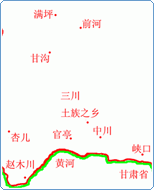
|
Tourist
Area of the Sources of Three Rivers (Changjiang, Huanghe and Lancangjiang
River) mainly refers to 6 counties, including Guanting, Zhongchuan,
Xing’er, Gangou, Manping, and Qianhe. It contains more than 80 administrative
village and nearly 300 villages. More than 750,000 people from different
ethnic groups live there, such as Tu, Hui, Tibetan, Dongxiang and
Sala. Tus are the major residents in the area with the population
more than 45,000 in the area.
The Tus
call themselves "Mongguer", "Chahan Mongguer",
and other names. There are different versions regarding the origin
of the Tus, but most people believe that the Tus evolved from the
Tuguhun people in ancient times. During their long history, they
formed their own unique group by absorbing members of the Han, Tibetan,
Mongolian, and other neighboring tribes.
The
Tu people have their own spoken language. Their language, which
is comprised of three dialects, belongs to the Mongolian branch
of the Altaic language family. The Tu people have no written alphabet.
As a result of generations of close contact with the Tibetans and
Mongolians, most Tus practice Tibetan Buddhism (Lamaism). Under
the influence of the Han people, they also worship their ancestors
and believe in the God of Wealth, the kitchen god, the door-god
and others. The Family God is also revered in all households as
the family protector.
There
is a long tradition of Tourist Area of the Sources of Three Rivers.
The area is more than half of the whole province with the elevation
above 4200 meters. There are East Kunlun Mountains, and its branch
ranges Buerhanbuda, Kekexili, Bayankela, Anyemaqen and Tanggula
Mountain with the elevation almost above 6000 meters. There are
wide grasslands between mountains. It has long been known as “the
sources of rivers” because of the great density of the network of
waterways. Lakes spread all over the area.
In recent
archaeological excavation, Lajia cultural site was authorized as
one of ten great archaeological discoveries in the nation. Turkish
embroidery is also excellent folk handicrafts in China.
The
Nadun Festival (meaning 'entertainment' and 'carnival' in the Tu
language) is a unique folk activity among the Tu ethnic people concentrated
in Minghe County, Northwest China's Qinghai Province. The festival
is held after harvesting the wheat in the summer, and usually lasts
63 days from July 12 to September 15 on the lunar calendar. It's
no wonder that some people call it the longest carnival in the world.
|
| Guanting
Town |
|
Guanting
Town is located at the south of the county, 90 km away
from county government and on northern bank of Huanghe
River. Tus are the major residents in the area with
the population more than 89.1% in the area. Guangting
Town contains 13 villages, including Xiadong, Zhong,
Xi, Lajia, Baojia, Zhaomuchuan, Xianfeng, Wushi, Bieluo,
Heyan, Guanghui, Qianjin, Zhaizi Village. Guangting
Turkish Town was founded in 1956, combined with Zhongchuan
and Xing’er Town in 1958, and was independent in 1984.
|
|
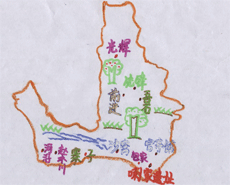 |
| Zhongchuan
Town |
|
Zhongchuan
Town is located at the south of the county, 87 km away
from county government and on northern bank of Huanghe
River. Tus are the major residents in the area with
the population more than 74% in the area. Zhongchuan
Town contains 14 villages, including Zhujialing, Langhucheng,
Hedong, Hexi, Hongya, Guangming, Qianjin, Qingyi, Qing’er,
Xiangyang, Nongchang, Jintian, Caotan, Meiyi villages.
Zhongchuan Town was founded in 1956, combined with Guanting
and Xing’er Town in 1958, and was independent in 1984.
|
|
 |
| Manping
Town |
|
Manping
Town is located at the south of the county, 60 km away
from county government and on northern bank of Huanghe
River. Hans and Huis are the major residents in the
area with the population more than 43% in the area,
while Tus occupies 2% of the populartion. Manping Town
contains 15 villages, including Xiaduo Er’bao, Chenjia,
Hekou, Jichang, Manping, Qingquan, Dazhuan, Shanzhuang,
Shalapo, Dongwan, Dahuai, Langtang, Xinjian, Yanglongping,
and Ao’gou Village. Manping Town was named Taihe Town
in 1949, founded in 1950, combined with Zhongchuan and
Xing’er Town in 1958, and was independent in 1984.
|
|
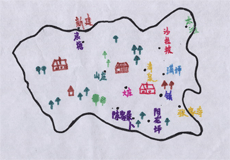 |
| Gangou
Town |
|
Gangou
Town is located at the south of the county, 70 km away
from county government and on northern bank of Huanghe
River. Hans are the major residents in the area , while
Hui occupies 35.8%, Tu occupies 19.4% and Tibetans occupies
10.6%. Gangou Town contains 13 villages, including Guangming,
Lijia, Hanjiazui, Xiamen, Huzhu, Jiefang, Tuanjie, Minzu,
Jingning, Dongshan, Zangan, Qianjin, and Gaizitan Villages.
Gangou Town was named Jingning Town in 1931, founded
in 1956, combined with Zhongchuan and Xing’er Town in
1958, and was independent in 1984.
|
|
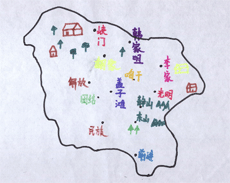 |
| Xing’er
Town |
|
Xing’er
Town is located at the southwest of the county, 110
km away from county government and on northern bank
of Huanghe River. Tibetans are the major residents in
the area with the population more than 68% in the area.
Xing’er Town contains 7 villages, including Xia’dazhuan,
Shengli, Rizha, E’wa, Luanshitou, Kasawa, and Xiela
Village. Xing’er Town was founded in 1956, combined
with Zhongchuan and Xing’er Town in 1958, and was independent
in 1984.
|
|
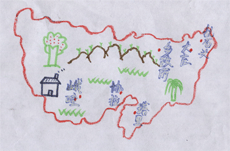 |
| Qianhe
Town |
|
Qianhe
Town is located at the middle south of the county, 64
km away from county government and on northern bank
of Huanghe River. Tus are the major residents in the
area with the population more than 35.8% in the area,
while Huis occupy 34.5% of the population. Qianhe Town
contains 12 villages, including Fengyi, Feng’er, Wotian,
Mangla, Tianjia, Taiqi, Moujiasi, Shangwan, Xiawan,
Ganjiachuan, Qianhe, Zhangjiasi Village. Guangting Turkish
Town was founded in 1956, combined with Zhongchuan and
Xing’er Town in 1958, and was independent in 1984.
|
|
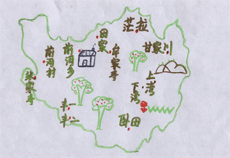 |
| |
|
|